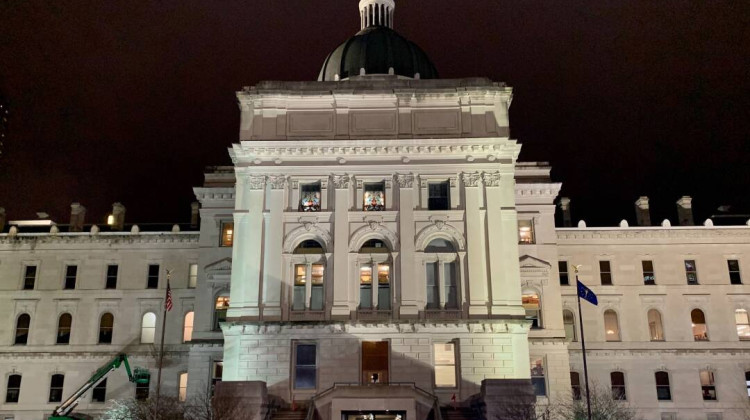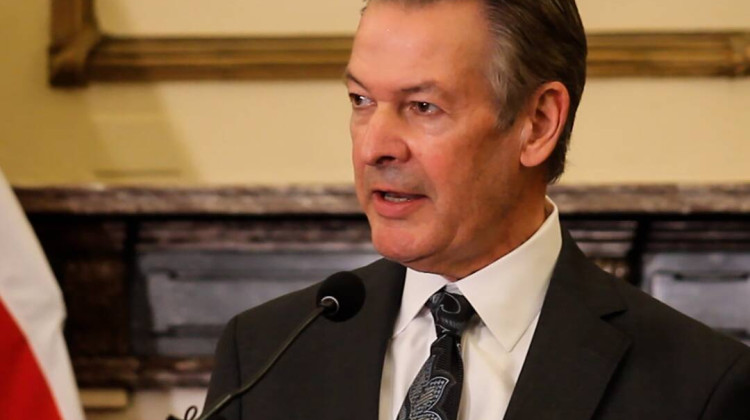
State Medicaid Director Cora Steinmetz, right, discusses managed care with lawmakers on Sept. 28, 2023.
Whitney Downard/Indiana Capital ChronicleBy WHITNEY DOWNARD, Indiana Capital Chronicle
As Hoosiers are getting older and Indiana’s long-term care system evolves to embrace the needs of a more complicated population, state officials are finalizing a potential $15 billion worth of contracts pivoting to managed care.
Managed care is a model for delivering health care services, ranging from in-home offerings to institutionalized care like nursing homes. Under such a system, one key entity manages each aspect of care for a consumer for a flat, up-front sum per person, rather than providers individually charging the state piecemeal for each service, also known as fee-for-service.
The vast majority of the state’s current Medicaid enrollees already operate under managed care, with the exception of one key program: elderly and disabled Hoosiers dependent upon long-term care.
In March, the agency tasked with managing the state’s Medicaid program quietly recommended four different Managed Care Entities (MCE) for the state’s program: Anthem Blue Cross and Blue Shield, Humana Healthy Horizons in Indiana, Molina Healthcare of Indiana and United Healthcare Community Plan.
“Through a person-centered approach, these MCEs will be integral to achieving our goals to make it easier for individuals to get home services, to create seamless coordination between Medicaid and Medicaid, to align quality with payment and to bend the cost curve related to caring for a growing aging population,” the Family and Social Services Administration (FSSA) webpage about managed care said.
The program will go live on July 1, 2024, according to the department, and qualifying Hoosiers will choose their programs early next year.
The stakes
By the year 2035, the number of adults over the age of 65 is expected to outnumber the number of children under 18 — in Indiana, a state with a disproportionately older population, that date is likely even sooner.

But Indiana, a state with a high number of nursing homes per capita, historically didn’t invest in home- and community-based services (HCBS). According to a Thursday presentation from FSSA, dollars dedicated to institutional care jumped in the last decade — the population covered under a fee-for-service model — while HCBS and managed care spending remained relatively flat.
“Institutionalized care has increased at a rate outpacing some of our other types of benefit categories … (from) 2016 to 2023,” said Cora Steinmetz, the state’s Medicaid director. “The per member, per month costs for managed care populations increased by 18% whereas the institutionalized population per member, per month over that same time period … increased by 42%.”
By transitioning to managed care, FSSA said Hoosiers will have better choices and quality of care while keeping cost increases more sustainable for government payers.
The MCEs
Contracts will not be executed until all four MCEs undergo a “robust readiness review.”
“Multiple MCEs have been recommended for award, in line with programs such as HIP, Hoosier Healthwise and Hoosier Care Connect, to allow members choice of which health plan would best serve their needs,” said FSSA in a statement to the Indiana Capital Chronicle. “Each MCE will have to provide services statewide, and having multiple plans allows members to switch plans to fit their needs and allows us to integrate with Medicare services for those who are eligible.”
Dually eligible Hoosiers, or those who qualify for both Medicare and Medicaid, often struggle to navigate the incompatible systems, as FSSA acknowledges on this webpage dedicated to the process.
“These programs are currently disconnected and siloed,” the FSSA website said. “Our managed LTSS system will feature seamless coordination of benefits regardless of program or setting and significantly reduce the confusion created by navigating multiple plans. Increased coordination between these programs will make accessing and navigating the entirety of the care/support continuum easier.”
Large portions of MCE proposals and supplemental materials are redacted, including sections on how each company would incentivize and build up Indiana’s workforce — a key concern for Indiana’s stakeholders. While the documents are public, their page numbers total in the tens of thousands and include highly technical information.
But the pages also include information about how MCEs will coordinate housing and transportation assistance as well as Memory Cafes, a program designed to be a safe and welcoming space for individuals with memory loss.
Some MCEs also indicated how they would handle future plans for Indiana’s long-term care system, such as self-directed care — a big concern for AARP’s Long-Term Services and Supports Scorecard, where Indiana fell in the middle of the pack.
The road ahead
Designing the state’s PathWays for Aging, the official program name, started in January 2021 but enrollees and providers themselves didn’t see much difference until recently as the state entered its ‘Readiness Review’ portion.
That process includes maintaining a continuity of care while increasing options for Hoosiers in need of services.
The Indiana Health Care Association (IHCA), which lobbies on behalf of the state’s nursing homes, pushed hard against managed care in previous legislative cycles, citing uncertainties around pivots to home care.
“From the outset, (our) primary concern with the transition to a managed care model has been the introduction of additional layers between our health care providers and the care they provide to their residents,” the IHCA and Indiana Center for Assisted Living (INCAL) said in a statement. “While work still remains prior to the program’s launch in 2024, we appreciate FSSA’s partnership and will continue to work with them over the next year to ensure our providers have the tools that are necessary to maintain high-quality care for their residents in the new managed care environment.”
Concerns for AARP, which advocates on behalf of many utilizing these care services, Indiana include ensuring clear communication that is “culturally competent, empathetic and also very instructive,” Sarah Waddle, the AARP Indiana state director said.
“There aren’t a lot of stakeholders around the table that have this solely consumer lens and we have been looking at this with that person in the forefront,” Waddle said. “I think we just want to make sure that this is the easiest transition for folks that it can possibly be and it goes smoothly.”
 DONATE
DONATE








 Support WFYI. We can't do it without you.
Support WFYI. We can't do it without you.